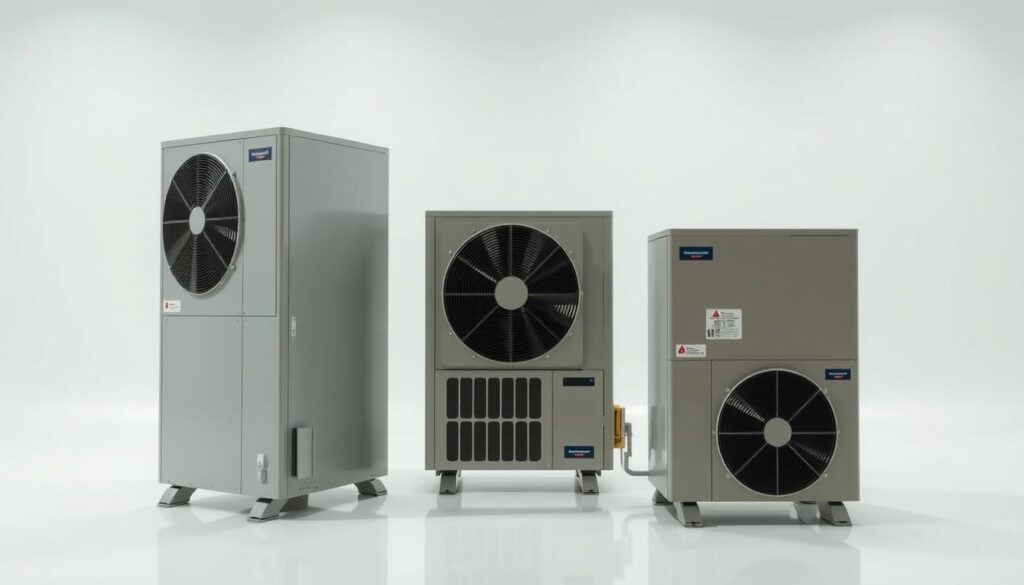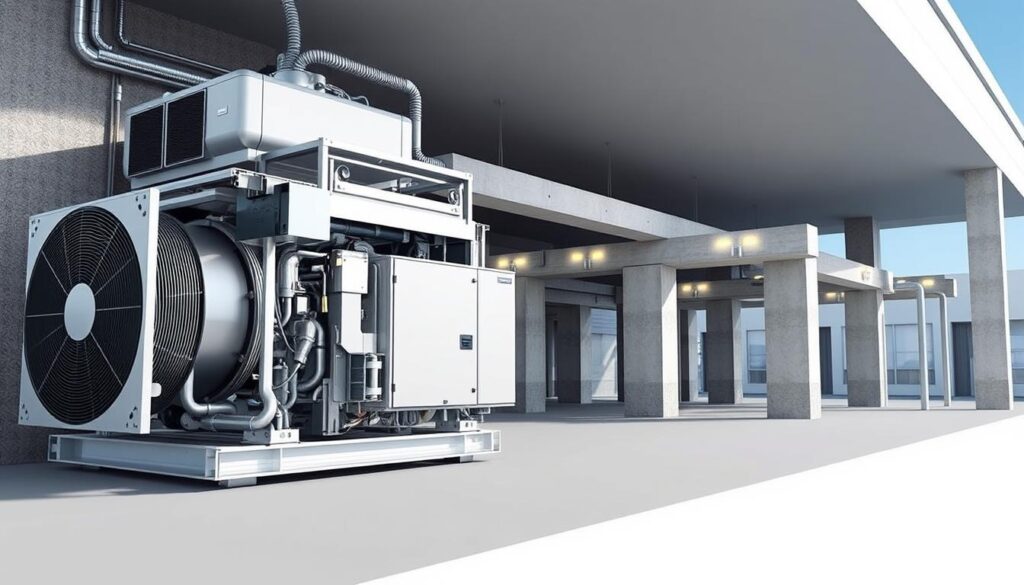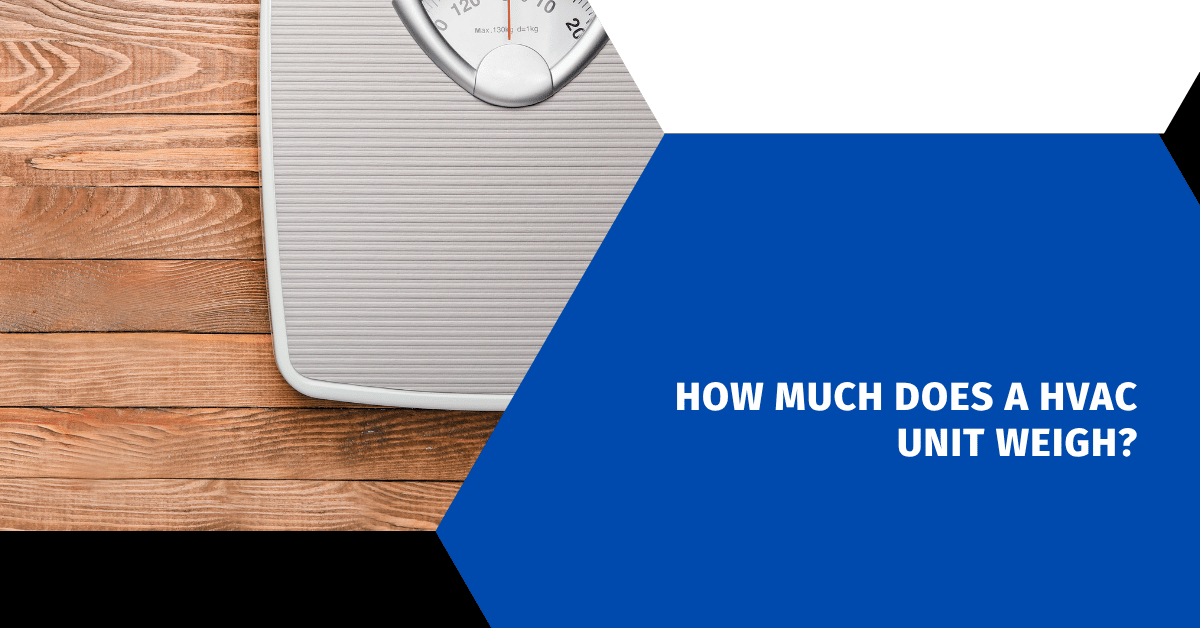Affiliate Disclosure
HVAC Guide Guys is a participant in the Amazon Services LLC Associates Program, an affiliate advertising program designed to provide a means for sites to earn advertising fees by advertising and linking to Amazon.
How Much Does a HVAC Unit Weigh? Ever thought about the weight of your home’s cooling system? Knowing how much a HVAC unit weighs is key. A typical air conditioner’s outside unit can weigh 150 to 210 pounds. But why are these systems so heavy?

Understanding the weight of a HVAC unit is more than just a fun fact. It affects everything from how it’s installed to the structure of your home or business. Different HVAC systems have vastly different weights, surprising even seasoned contractors.
If you’re getting a new HVAC, thinking about replacing one, or just curious, knowing the weight is essential. It gives you important insights into these complex systems.
Key Takeaways
- HVAC unit weights vary significantly by system type
- Residential outside units typically weigh 150-210 pounds
- Weight impacts installation, transportation, and structural planning
- Different HVAC types have unique weight characteristics
- Professional assessment is key for the right unit choice
Table of Contents
Understanding HVAC Unit Weight Basics
Exploring HVAC systems can be tricky, with terms like hvac tonnage weight and ac unit weight causing confusion. Many think “tonnage” means the unit’s weight, but it’s actually about cooling capacity.
HVAC tonnage measures how much cooling a unit can handle, not its weight. A 4-ton unit can cool your space by removing 48,000 BTUs of heat per hour. This is because one ton can cool the same as melting 2,000 pounds of ice in 24 hours.
Weight vs. Tonnage Explained
The weight of an AC unit and its cooling capacity are not directly related. Several factors affect the weight of HVAC equipment:
- Size of the cooling system
- Materials used in construction
- Number of internal components
- Efficiency rating
Factors Affecting HVAC Unit Weight
Several elements influence an HVAC unit’s weight:
- Compressor type: Different designs affect the unit’s weight
- Metal thickness: Thicker metals make the unit heavier
- Insulation materials: Soundproofing and thermal protection add weight
Common Weight Measurements
HVAC units have different weights based on their size and design. Installers must consider these weights when placing and installing units.
| Cooling Capacity | Typical Weight Range | Installation Considerations |
|---|---|---|
| 2-ton unit | 150-250 pounds | Residential single-story homes |
| 4-ton unit | 300-500 pounds | Larger homes or multi-story buildings |
| 5-ton unit | 450-650 pounds | Commercial spaces or large residential properties |
Explore Our HVAC Shop
Looking for top-rated HVAC tools, parts, and accessories? Visit our shop and find the perfect solution for your needs.
Visit the ShopResidential AC Unit Weight Range
Knowing the weight of your home’s AC unit is key when you’re getting a new one. The weight of your AC unit can change a lot based on a few important things. Usually, the outside unit of a home air conditioner weighs between 150 to 210 pounds when it’s shipped.
Every AC unit is different, and so is their weight. This affects how easy it is to move and install them. Here are some important things to think about when it comes to AC unit weight:
- Small window units weigh around 50-80 pounds
- Mid-size central air systems range from 150-250 pounds
- Large residential systems can exceed 300 pounds
The weight of your AC unit depends on several things, including:
- Cooling capacity
- Manufacturer design
- Materials used in construction
- Additional technological features
“Knowing your AC unit’s weight helps ensure proper installation and structural support.”
| AC Unit Type | Average Weight | Installation Complexity |
|---|---|---|
| Window Unit | 60-120 lbs | Low |
| Split System | 150-250 lbs | Medium |
| Central Air System | 250-400 lbs | High |
When you’re getting a new AC unit, talk to professional HVAC technicians. They can give you the exact weight and help with the installation based on your home’s needs.
How Much Does a HVAC Unit Weigh for Different Types
Understanding the weight of HVAC units is key for proper installation and moving. AC units come in different weights, affecting where they can go and how they’re moved. Let’s look at the weight ranges for various HVAC systems.
Window Unit Weights
Window AC units are the lightest HVAC systems. They weigh between 60 to 120 pounds. The smaller units for single rooms are lighter, while bigger units for larger spaces are closer to 120 pounds.
- Small rooms (5,000 BTU): 40-60 pounds
- Medium rooms (8,000-12,000 BTU): 70-90 pounds
- Large rooms (15,000-25,000 BTU): 100-120 pounds
Portable AC Unit Weights
Portable air conditioners are flexible in weight. They usually weigh between 50 to 80 pounds, making them easy to move. Their weight depends on cooling capacity and extra features.
| Cooling Capacity | Average Weight | Best Used For |
|---|---|---|
| 8,000 BTU | 50-60 pounds | Small rooms |
| 12,000 BTU | 65-75 pounds | Medium rooms |
| 14,000 BTU | 75-85 pounds | Large rooms |
Central Air Conditioning Systems
Central air conditioning systems are the heaviest. Their weight ranges from 200 to 1,500 pounds, depending on size and capacity. Home systems usually weigh 300-600 pounds, while commercial ones are much heavier.
- Residential systems: 300-600 pounds
- Commercial systems: 600-1,500 pounds
Explore Our HVAC Shop
Looking for top-rated HVAC tools, parts, and accessories? Visit our shop and find the perfect solution for your needs.
Visit the ShopCommercial HVAC System Weights
Commercial HVAC systems are much heavier and more complex than home units. They can weigh between 1,000 to 7,500 pounds. This depends on the system’s needs and the building’s requirements.
It’s important for architects, engineers, and facility managers to know the weight of these units. They are built to handle big cooling and heating needs. This is for large spaces like office buildings, warehouses, and industrial areas.
- Rooftop commercial HVAC units typically weigh 2,000-5,000 pounds
- Large industrial systems can exceed 6,000 pounds
- Modular commercial hvac unit weight varies based on capacity
The weight of these units comes from several things:
- Robust metal frameworks
- Heavy-duty compressors
- Extensive cooling and heating components
- Advanced technological systems
Different places need different weights for their HVAC systems. Smaller retail spaces might use lighter units. But, huge industrial places need much heavier systems.
| Commercial HVAC Type | Typical Weight Range | Primary Application |
|---|---|---|
| Rooftop Package Units | 2,000-4,500 lbs | Office Buildings |
| Large Industrial Systems | 5,000-7,500 lbs | Manufacturing Facilities |
| Modular Commercial Units | 1,500-3,500 lbs | Retail Spaces |
When setting up a commercial HVAC system, you need to think about a few things. You must check if the building can support the weight. You also need to plan how to move and install the system. The weight of these systems affects the building’s design and mechanical setup.
Weight Considerations for Installation
Installing an HVAC system requires careful planning. The weight of your HVAC unit is key to the installation’s complexity and safety.
Professional HVAC technicians assess many factors for installation. They prepare to ensure a smooth and safe setup for your cooling system.
Roof Load Requirements
When installing rooftop HVAC units, the building’s structure is important. Different structures can handle different weights, affecting where the HVAC can go.
- Residential roofs can handle 20-30 pounds per square foot
- Commercial buildings might support more
- Structural engineers can give exact load calculations
Installation Equipment Needs
The weight of your HVAC unit affects the installation equipment needed. Heavier units require stronger lifting and positioning tools.
| HVAC Unit Weight | Required Equipment |
|---|---|
| 0-150 pounds | Manual lifting equipment |
| 150-500 pounds | Hydraulic lifts and cranes |
| 500+ pounds | Heavy-duty crane and specialized rigging |
Safety Considerations
Safety is the top priority during HVAC installation. Always choose professional installation for heavy units. Trained technicians know the risks and follow safety rules.
- Use the right personal protective equipment
- Ensure proper weight distribution
- Follow the manufacturer’s installation guidelines
- Do a thorough site assessment before starting
Explore Our HVAC Shop
Looking for top-rated HVAC tools, parts, and accessories? Visit our shop and find the perfect solution for your needs.
Visit the ShopHVAC Unit Weight by Capacity

Choosing the right HVAC system is easier when you know about hvac sizing weight. HVAC units are measured in tonnage, which shows their cooling power, not their weight. A single ton means 12,000 BTUs per hour, which is key for picking the right system.
The weight of your HVAC unit changes with its capacity. Home systems usually range from 1.5 to 5 tons. Each ton has its own weight, and smaller units might not cool big spaces well.
- 1-2 ton units: 150-300 pounds
- 2-3 ton units: 300-450 pounds
- 3-5 ton units: 450-700 pounds
Experts say to match the unit’s weight and capacity to your building. Bigger doesn’t always mean better when it comes to hvac sizing weight. Too big, and it won’t cool efficiently and will use more energy.
Things that affect HVAC unit weight include:
- Cooling capacity
- Materials used in construction
- Compressor type
- Additional features and components
When picking an HVAC system, talk to pros. They can figure out what you need and suggest the best unit for your space, considering weight, capacity, and energy use.
Transportation and Handling Requirements
Moving an HVAC unit needs careful planning and the right tools. The weight of the unit is key in choosing how to move it safely. Experts must think about many things to move these systems well.
For moving HVAC units, you need the right gear based on the unit’s weight and size. Each unit needs a special way to move it to avoid damage and keep workers safe.
Equipment Required for Moving
- Hand trucks for lightweight units (60-120 pounds)
- Specialized dollies with heavy-duty wheels
- Hydraulic lifting equipment for commercial systems
- Crane services for large rooftop installations
Safety Protocol for Transport
- Conduct a pre-move weight assessment
- Use appropriate personal protective equipment
- Secure the HVAC unit with professional-grade straps
- Check weight distribution during transportation
- Follow manufacturer-recommended handling guidelines
Professional HVAC technicians know moving units right is key. The right tools and careful handling can stop expensive damage and make sure your system is ready for installation.
Weight Impact on Building Structure

When you plan to install an HVAC system, knowing how it affects your building’s structure is key. The weight of commercial HVAC systems can put a lot of stress on foundations, roofs, and support systems. It’s important to have structural engineers check if your building can handle the weight of these systems.
Every building is different and can handle different weights. Older buildings might need extra support for modern HVAC systems. Architects and engineers must look closely at:
- Roof load-bearing capabilities
- Floor structural integrity
- Foundation strength
- Material composition of support structures
For commercial HVAC installations, how the weight is spread out is very important. Uneven weight can cause structural problems. Getting a professional assessment can prevent damage and ensure your HVAC system works well for a long time.
Before you install any HVAC unit, you should do a detailed check of your building’s structure. This helps find out if you need to add extra support and avoids expensive changes later. Professional engineers can give you specific advice based on your building’s needs.
Proper planning prevents possible structural issues during HVAC installation.
Your building’s special features will decide the best HVAC system for it. Understanding weight issues early helps you make choices that keep your building safe.
Explore Our HVAC Shop
Looking for top-rated HVAC tools, parts, and accessories? Visit our shop and find the perfect solution for your needs.
Visit the ShopSize and Weight Relationship in HVAC Units
Understanding how size and weight relate in HVAC units is key for homeowners and HVAC pros. The weight of an AC unit affects its performance, installation, and efficiency.
Different HVAC systems have unique weights based on several factors. Your choice of unit impacts installation needs and long-term performance.
Compact vs. Full-Size Units
When looking at hvac unit weight, some important differences show up:
- Compact units weigh between 50-150 pounds
- Full-size central air conditioning systems weigh 200-800 pounds
- Residential units usually weigh less
Weight Distribution Factors
Several key elements affect ac unit weight distribution:
- Material composition – Different metals and parts change the weight
- Internal mechanical structures
- Cooling system complexity
- Energy efficiency ratings
Professional installers must consider these factors for proper placement and support of your HVAC system.
Conclusion
Knowing how much an HVAC unit weighs is key for a successful installation and upkeep. The weight of your HVAC system is vital for choosing the right one for your home or business. Units vary from light window models to heavy commercial systems, each needing careful weight consideration.
Experts say it’s important to evaluate thoroughly before picking or swapping systems. The weight affects not just moving and setting up, but also the building’s structural load. Home units usually weigh 60-150 pounds, while commercial ones can be much heavier, over 300 pounds.
When setting up your HVAC, talk to certified pros who get the weight and structure needs. They guide you through the complex choices based on unit weight and your building’s needs. This ensures you get a system that fits perfectly.
Understanding HVAC unit weights is essential for a good investment and performance. By focusing on these details, you’ll get efficient and reliable heating and cooling for many years.

